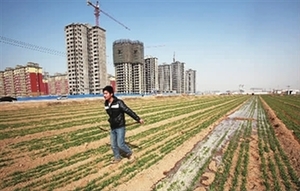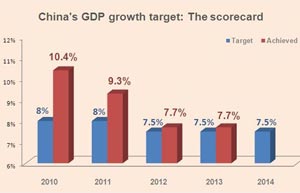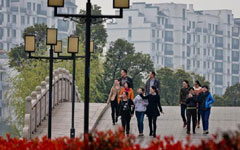New urbanization plan ambitious: Analysts
By Zheng Yangpeng (China Daily) Updated: 2014-03-18 07:34Although the urbanization plan is more of a response than an initiative, some experts do see solid benefits from it.
"This plan emerged at a time when the Chinese economy faces increasing downward pressures," said Yi Peng, a researcher with Pangoal, a think tank.
Analysts also said the implementation of the plan will be challenging. China's urbanization process, although it has only recently just passed its halfway mark, has already shown signs of slowing. The urbanization ratio, measured as the urban population's share of the total population, rose by only 1.16 percentage points in 2013, according to the National Bureau of Statistics. That's the slowest since 1996, except for 2008, when the global financial crisis hit China.
Analysts said this is why in the plan the government set a low-key goal for the urbanization ratio: The number should rise to 60 percent of the total population by 2020. Given China's urbanization ratio had already reached 53.7 percent by 2013, it means the nation should only add 0.9 percentage points annually in the following seven years to reach the goal.
However, the government is more concerned about quality of life, which also has its challenges. The plan states 45 percent of the population should have urban hukou (household registration permits) by 2020, which means they should have equal access to a variety of social entitlements linked with a hukou by then. By 2013, only 35.7 percent of Chinese held urban hukou. It is not generally regarded as being easy to add another 10 percent points to this figure.
This is why the plan states China will strive to narrow the gap between the urbanization ratio measured by regular residents and the urbanization ratio measured by urban hukou holders by 2 percentage points, indicating a stronger emphasis on social inclusion. Currently the gap between the two is 18 percentage points.
Realizing these goals will require considerable financial input. A Chinese Academy of Social Sciences report estimated the average cost for each rural resident to move will be 131,000 yuan ($21,480), of which 26,000 yuan will be covered by the government.
To cope with the financial challenge, the plan states there will be a "diversified" and "sustained" funding mechanism. For the first time, the State Council has agreed to allow local governments to issue municipal bonds.
Woetzel said municipal bonds are important but will not be enough. Local governments should be able to raise their fiscal revenues by levying property taxes and receiving more money from the central government.
 Urbanization should be for people's sake |
 |
- China unveils landmark urbanization plan
- China unveils urbanization plan for 2014-2020
- Financial investment system and policy innovation in the urban-rural integration of Chengdu
- Urbanization: major driving force of economic development
- A study on the strategy and measures on promoting the sound development of China's urbanization
- NHTSA says finds no 'defect trend' in Tesla Model S sedans
- WTO rare earth ruling is unfair
- Amway says 2014 China sales may grow 8%
- President Xi in Europe: Forging deals, boosting business
- CNOOC releases 2013 sustainability report
- Local production by Chery Jaguar Land Rover this year
- Car lovers test their need for speed in BMW Mission 3
- China stocks close mixed Monday



















